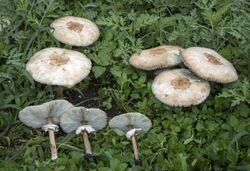Biology:Chlorophyllum molybdites
| Green-spored parasol Chlorophyllum molybdites | |
|---|---|

| |
| Picture of the fungi | |
| Scientific classification | |
| Domain: | Eukaryota |
| Kingdom: | Fungi |
| Division: | Basidiomycota |
| Class: | Agaricomycetes |
| Order: | Agaricales |
| Family: | Agaricaceae |
| Genus: | Chlorophyllum |
| Species: | C. molybdites
|
| Binomial name | |
| Chlorophyllum molybdites (G. Mey.) Massee (1898)
| |
| Synonyms | |
|
Agaricus molybdites | |
| Chlorophyllum molybdites | |
|---|---|
| Mycological characteristics | |
| gills on hymenium | |
| cap is flat | |
| hymenium is free | |
| stipe has a ring | |
| spore print is green | |
| ecology is saprotrophic | |
| edibility: poisonous | |
Chlorophyllum molybdites, commonly known as the green-spored parasol,[1] false parasol, green-spored lepiota and vomiter, is a widespread mushroom. Poisonous and producing severe gastrointestinal symptoms of vomiting and diarrhea, it is commonly confused with the shaggy parasol (Chlorophyllum rhacodes) or shaggy mane (Coprinus comatus), and is the most commonly misidentified poisonous mushroom in North America.[2] Its large size and similarity to the edible parasol mushroom (Macrolepiota procera), as well as its habit of growing in areas near human habitation, are reasons cited for this. The nature of the poisoning is predominantly gastrointestinal.
Description
It is an imposing mushroom with a pileus (cap) ranging from 8 to 30 cm (3.1 to 12 in) in diameter, hemispherical and with a flattened top. The cap is whitish in colour with coarse brownish scales. The gills are free and white, usually turning dark and green with maturity. It has a rare green spore print.[3] The stipe ranges from 5 to 30 cm (2.0 to 12 in) tall and bears a double-edged ring.[3] Its stem lacks the snakeskin pattern that is generally present on the parasol mushroom.[4] Flesh thick, firm at first, soft with age, white, unchanging or sporadically becoming reddish-brown to pale reddish-pink, almost orange in the base of the foot when cut or crushed.
Distribution and habitat
Chlorophyllum molybdites grows in lawns and parks across eastern North America and California , as well as temperate and subtropical regions around the world.[5] Fruiting bodies generally appear after summer and autumn rains. It appears to have spread to other countries, with reports from Scotland, Australia , and Cyprus.[6]
Toxicity
Chlorophyllum molybdites is the most frequently eaten poisonous mushroom in North America.[2] The symptoms are predominantly gastrointestinal in nature, with vomiting, diarrhea and colic, often severe, occurring 1–3 hours after consumption.[5] Although these poisonings can be severe, particularly in children,[3] none have yet resulted in death.[7]
Professor James Kimbrough writes:
Chlorophyllum molybdites, the green-spored Morgan's Lepiota, is responsible for the greatest number of cases of mushroom poisonings in North America, and in Florida. This is probably due to the fact that it is easily confused with choice edible species such as Lepiota procera and L. rhacodes, and it is one of the most common mushrooms found on lawns and pastures throughout the country, with the exception of the Pacific Northwest. When eaten raw C. molybdites produce severe symptoms, including bloody stools, within a couple of hours. When cooked well, or parboiled and decanting the liquid before cooking, others eat and enjoy it. Eilers and Nelso (1974) found a heat-labile, high molecular weight protein which showed an adverse effect when given by intraperitoneal injection into laboratory animals.[8]
Cases of poisoning from these mushrooms are also reported in Malaysia, where they are often mistaken for Termitomyces mushrooms that are found locally.[9]
Gallery
References
- ↑ Arora, David (1986). Mushrooms demystified: a comprehensive guide to the fleshy fungi (Second ed.). Berkeley: Ten Speed Press. ISBN 978-0-89815-169-5.
- ↑ 2.0 2.1 Beug, Michael W. An Overview of Mushroom Poisonings in North America. The Mycophile, vol. 45(2):4-5, March/April 2004
- ↑ 3.0 3.1 3.2 Davis, R. Michael; Sommer, Robert; Menge, John A. (2012). Field Guide to Mushrooms of Western North America. Berkeley: University of California Press. pp. 85. ISBN 978-0-520-95360-4. OCLC 797915861. https://www.worldcat.org/oclc/797915861.
- ↑ "How to not pass up a parasol and how not to". http://www.alanmuskat.com/articles/parasol2.htm.
- ↑ 5.0 5.1 Benjamin, Denis R. (1995). "Gastrointestinal syndrome". Mushrooms: poisons and panaceas — a handbook for naturalists, mycologists and physicians. New York: WH Freeman and Company. pp. 351–377. ISBN 0-7167-2600-9.
- ↑ Loizides M, Kyriakou T, Tziakouris A. (2011). Edible & Toxic Fungi of Cyprus (in Greek and English). Published by the authors. pp. 132–33. ISBN:978-9963-7380-0-7.
- ↑ "Chlorophyllum molybdites". Urban Mushrooms. http://urbanmushrooms.com/index.php?id=4.
- ↑ Common Florida Mushrooms, p. 325.
- ↑ Phan Chia Wei (17 December 2018). "Preventing fatal harvest of mushrooms". Asia Research News. https://www.asiaresearchnews.com/html/article.php/aid/12290/cid/2/research/medicine/university_of_malaya/preventing_fatal_harvest_of_mushrooms.html. Retrieved 14 July 2023.
External links
- Mushroom Expert – Chlorophyllum molybdites
- Tom Volk's Fungus of the Month – Chlorophyllim molybdites
- Your Yard Might Be Home to the "Vomiter" Mushroom | Huffington Post
Wikidata ☰ Q146693 entry
 |










